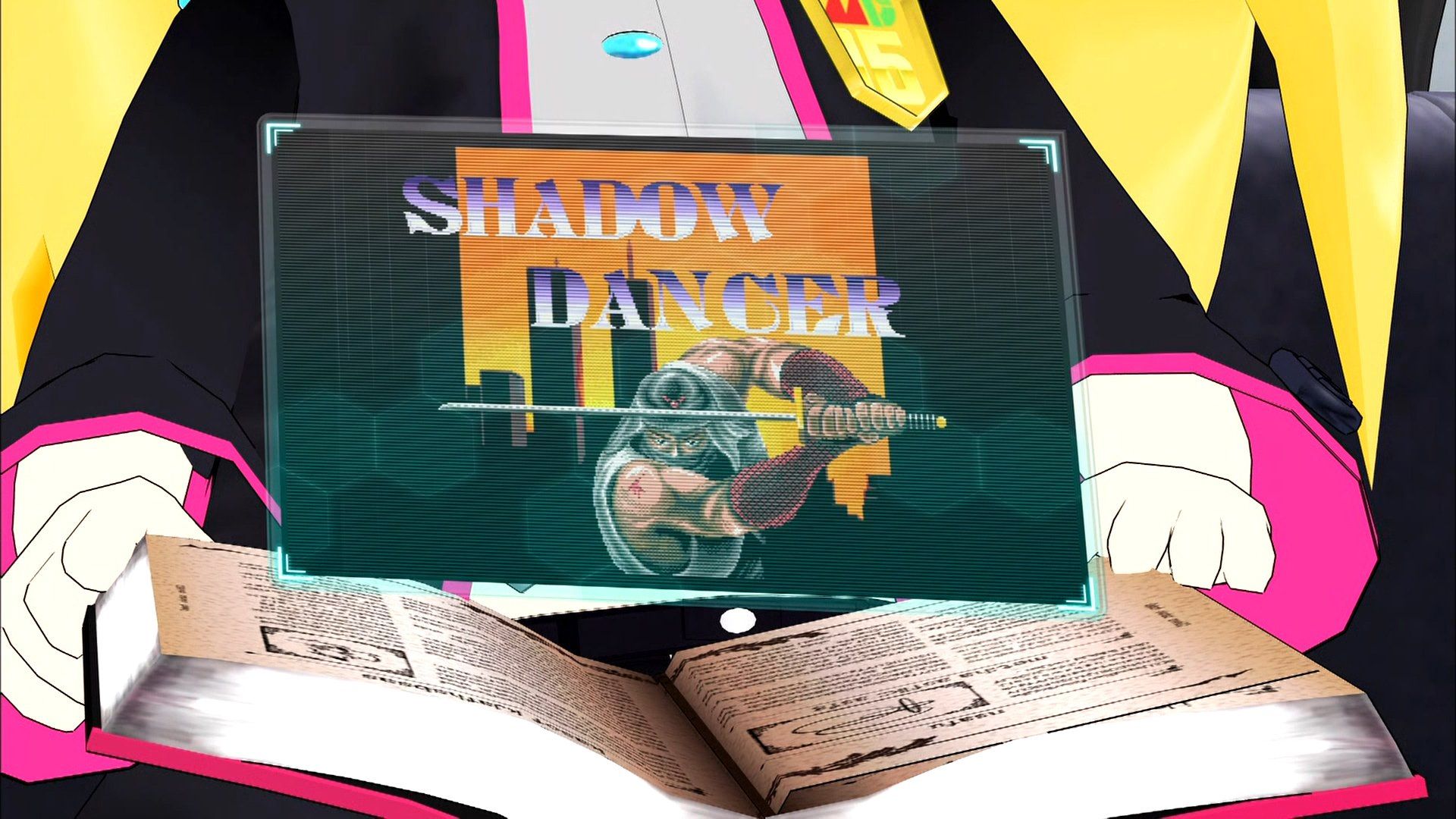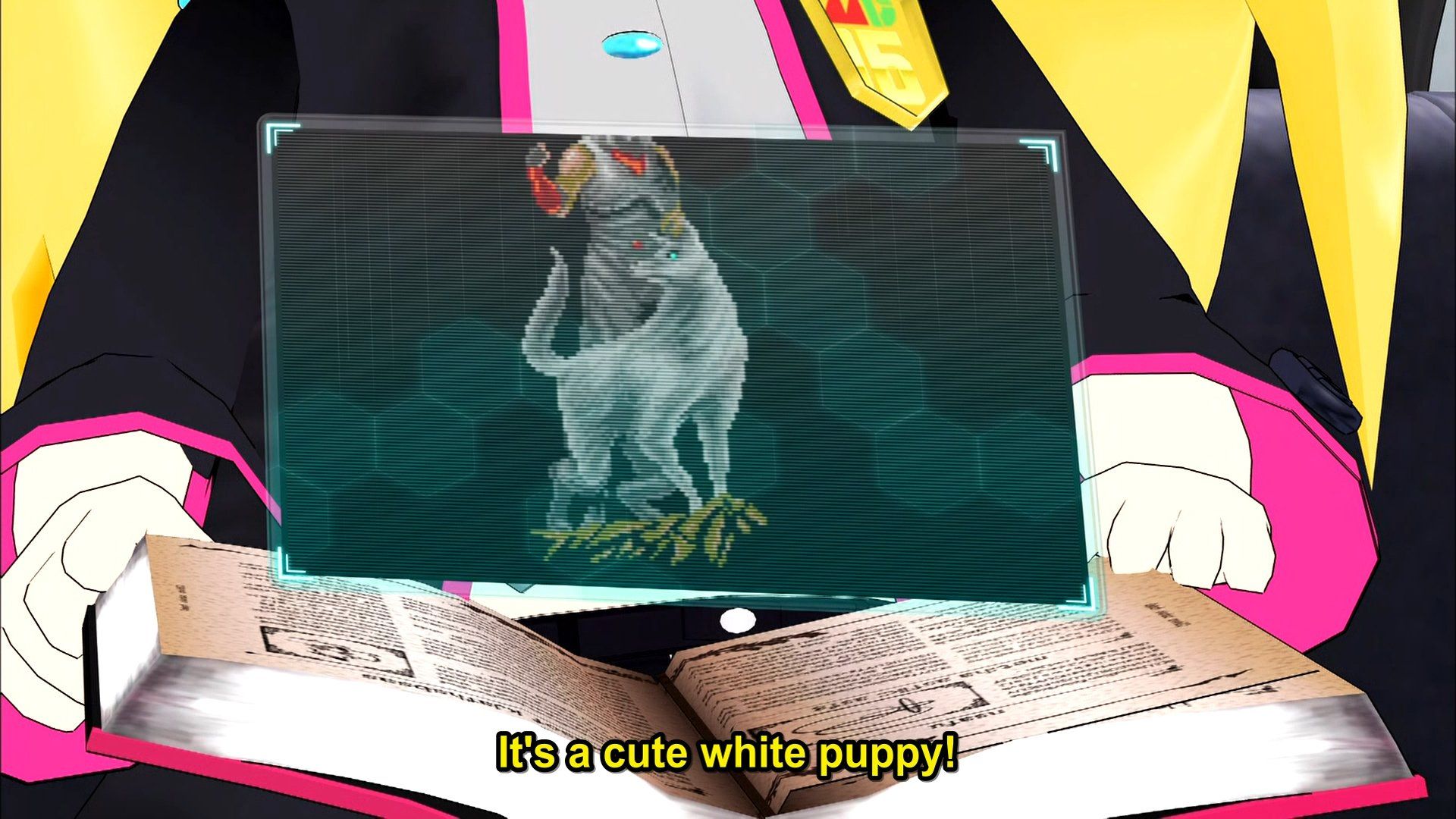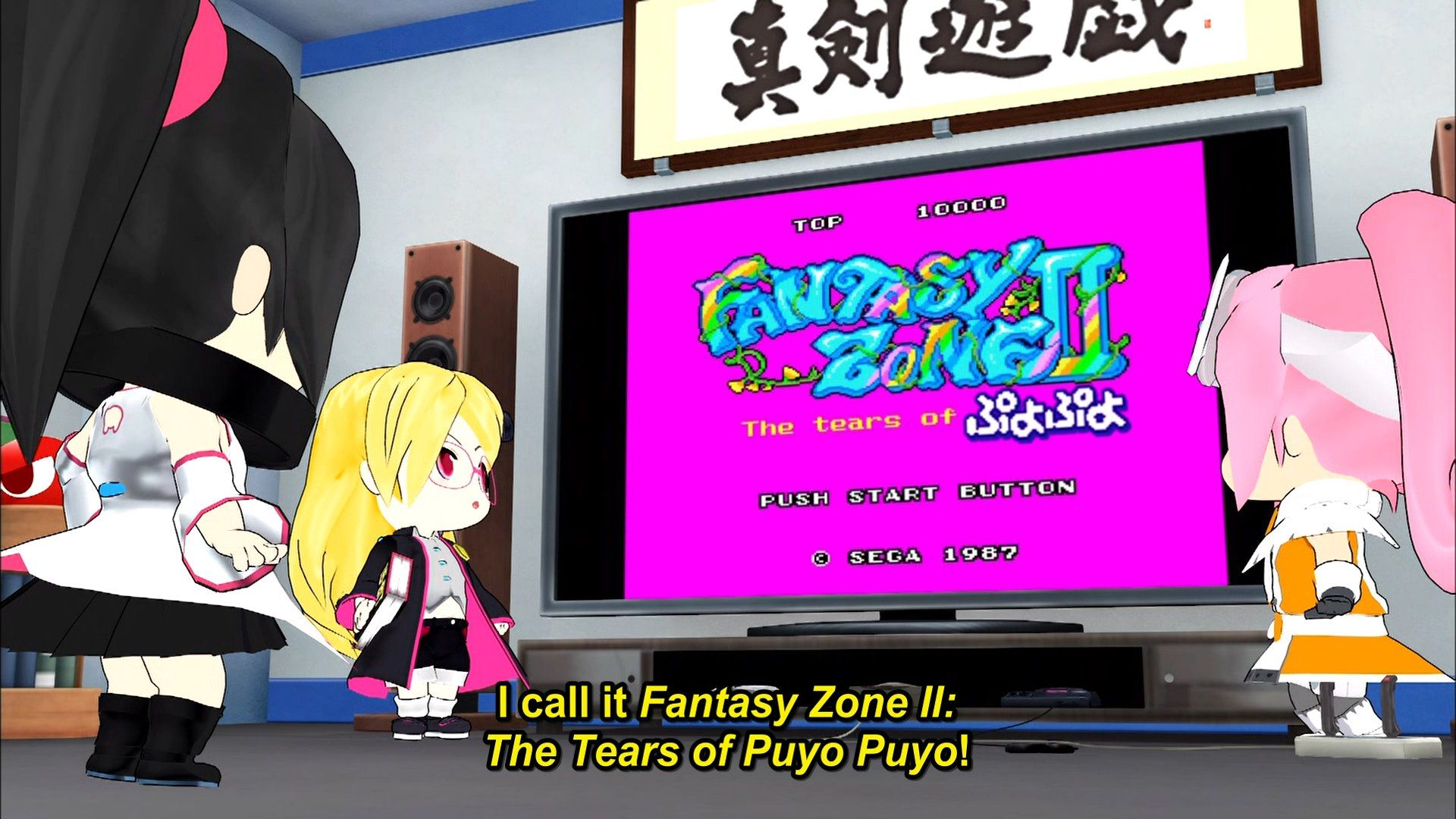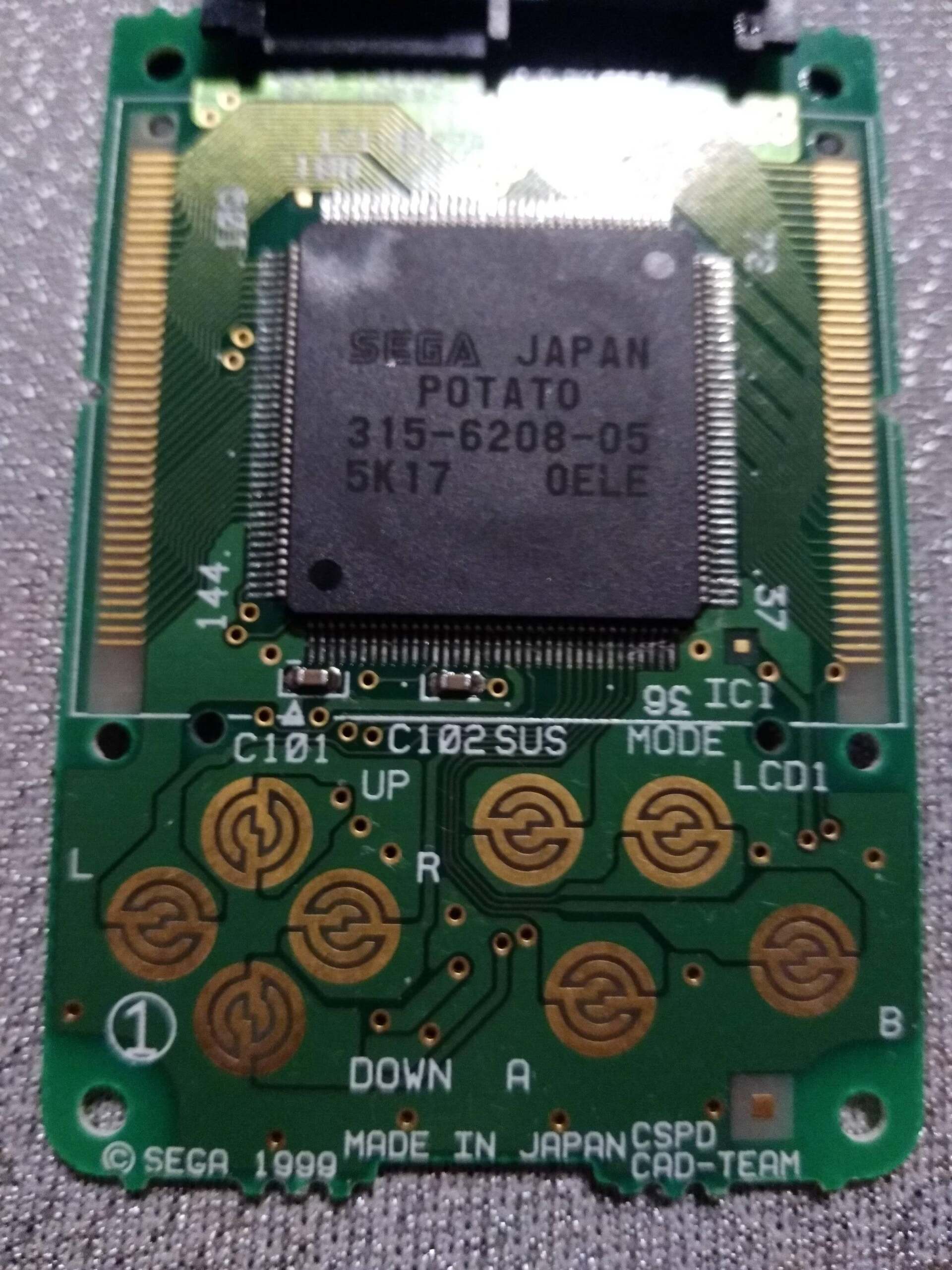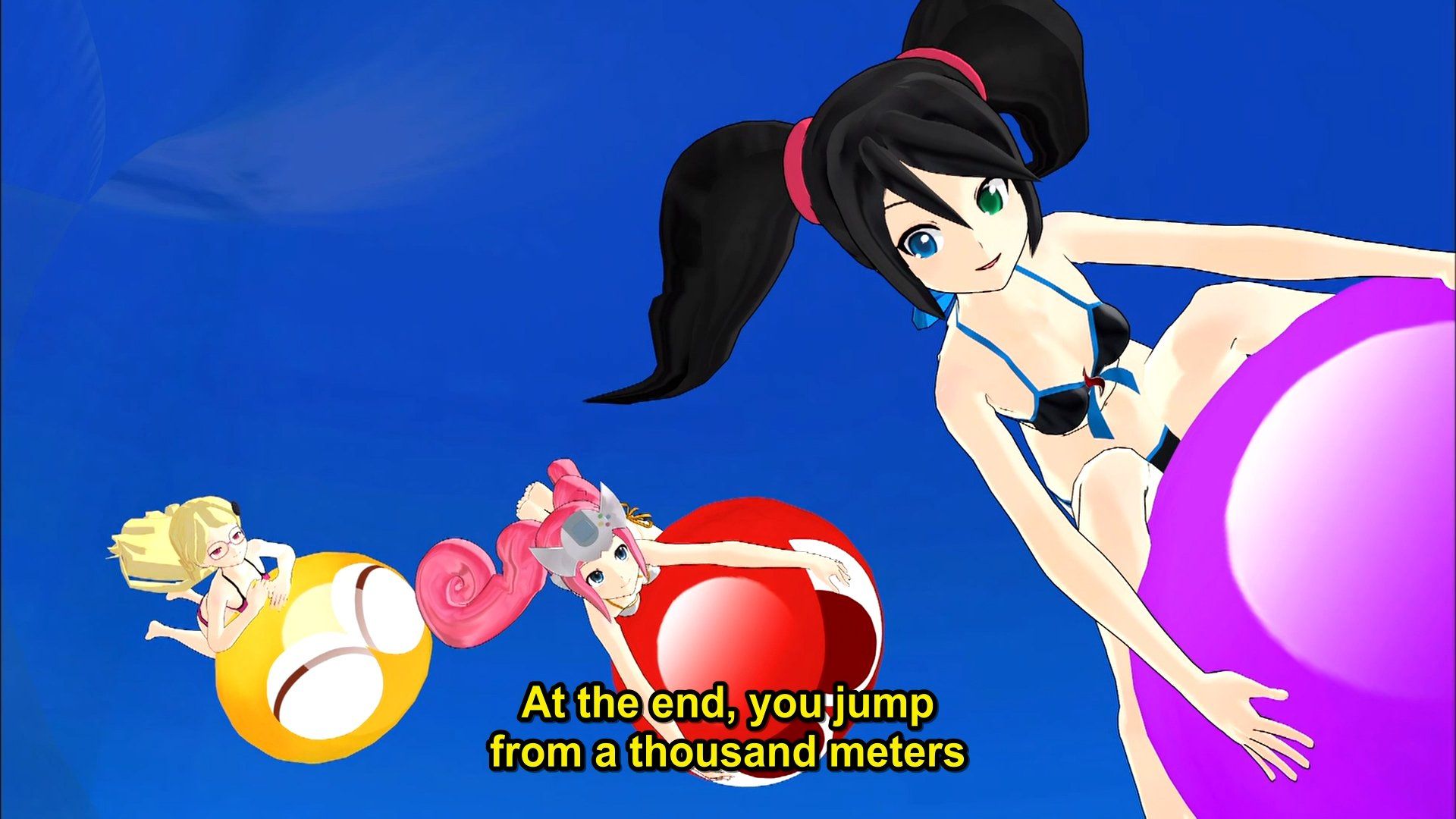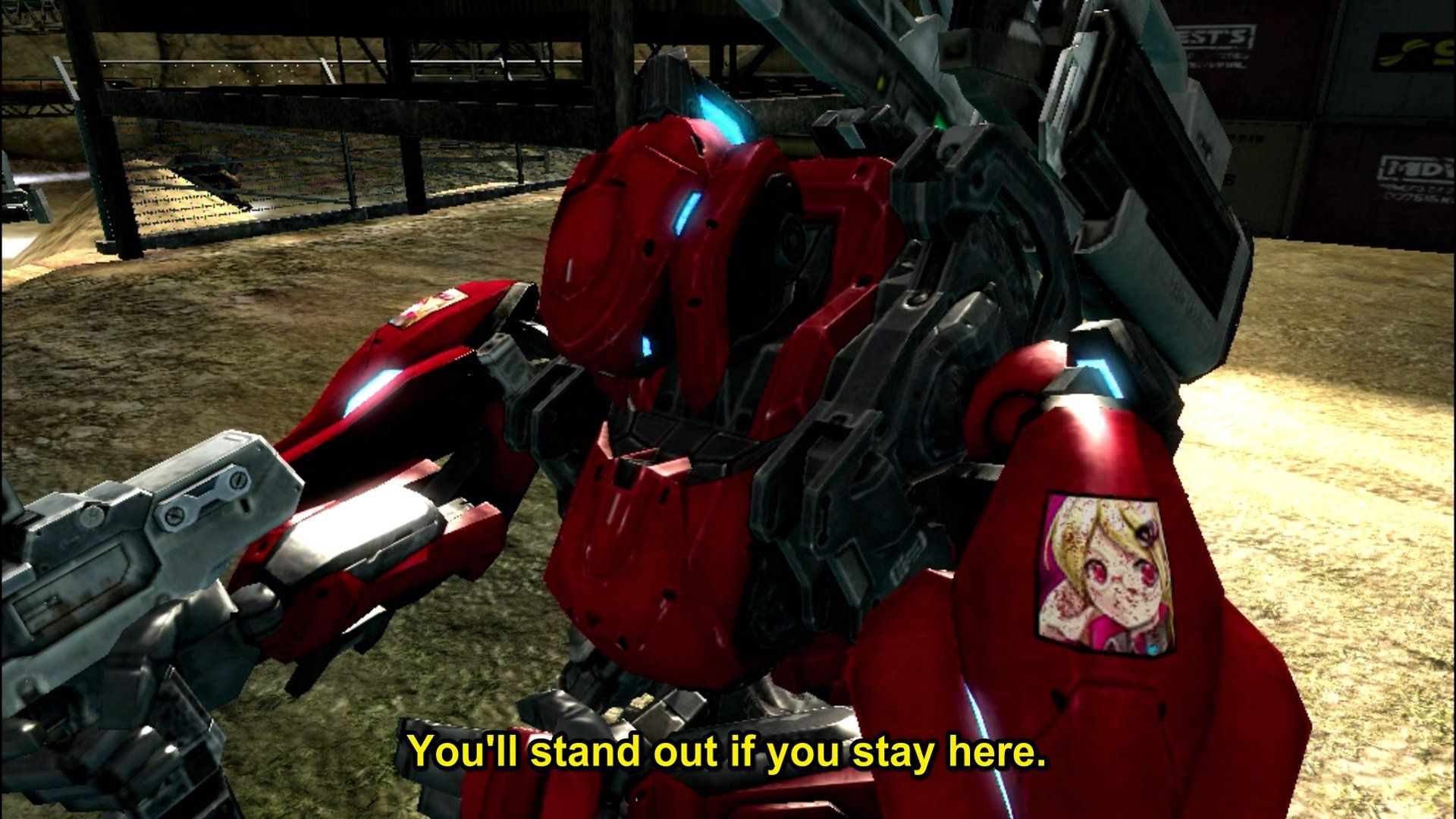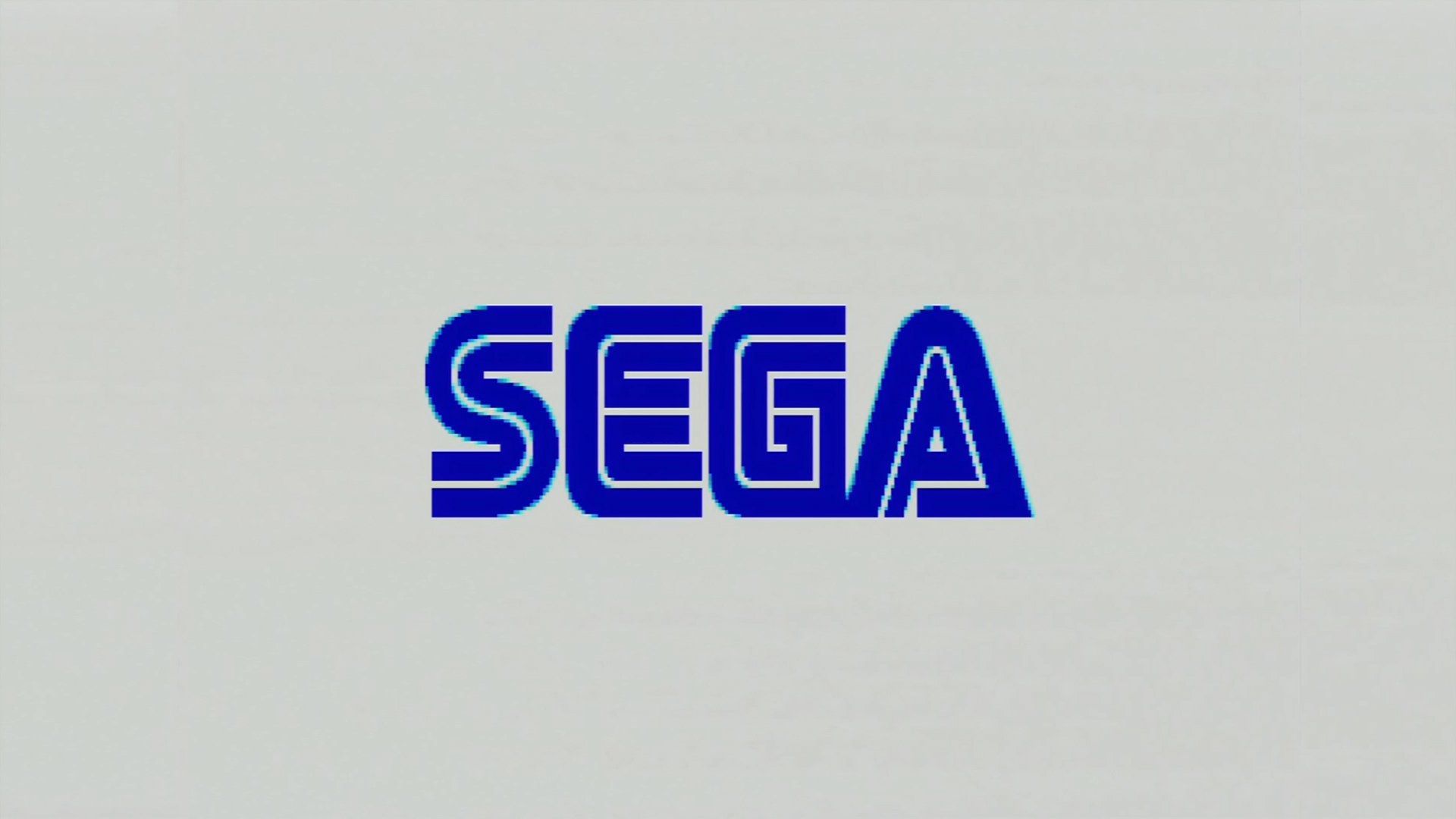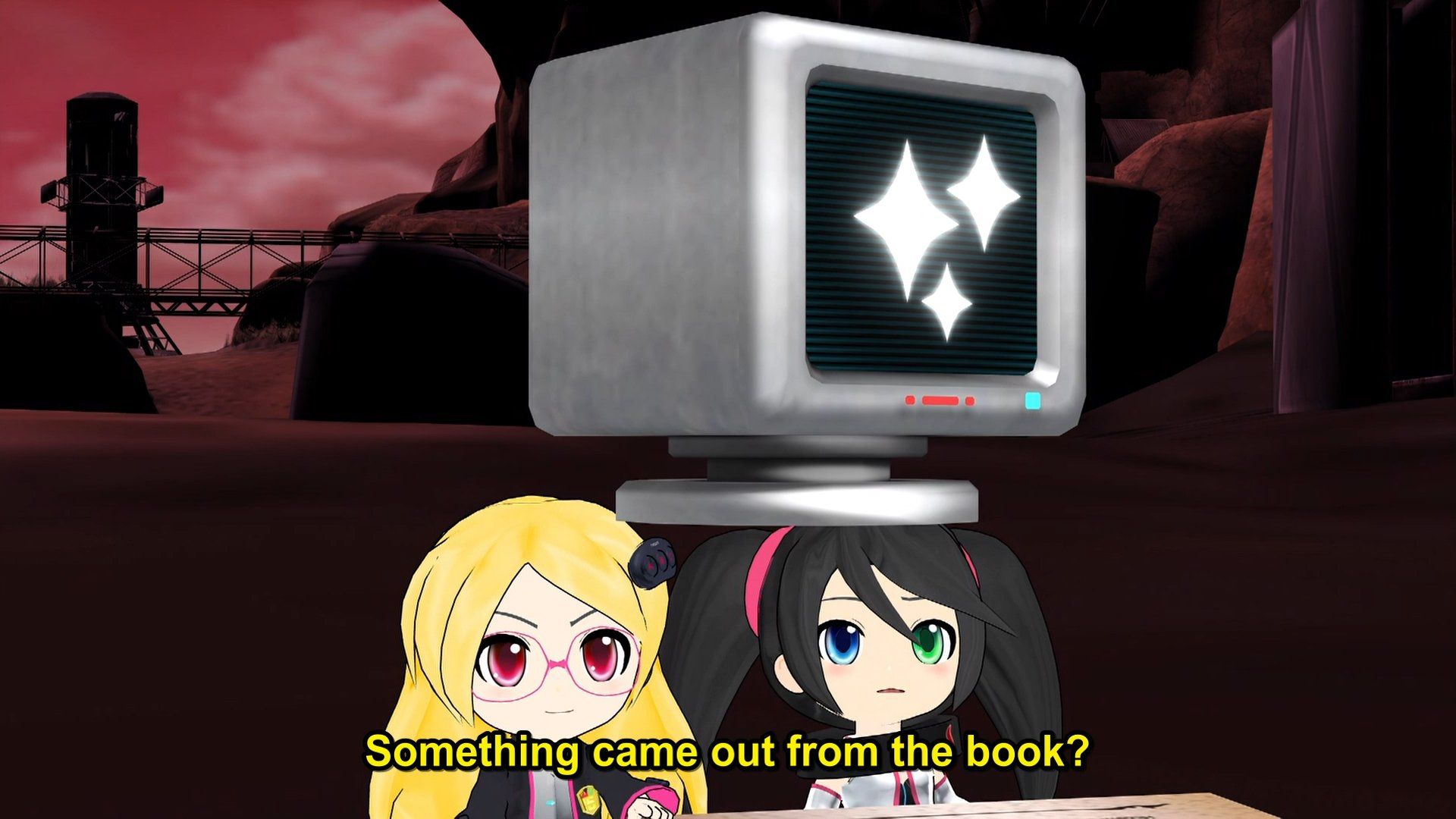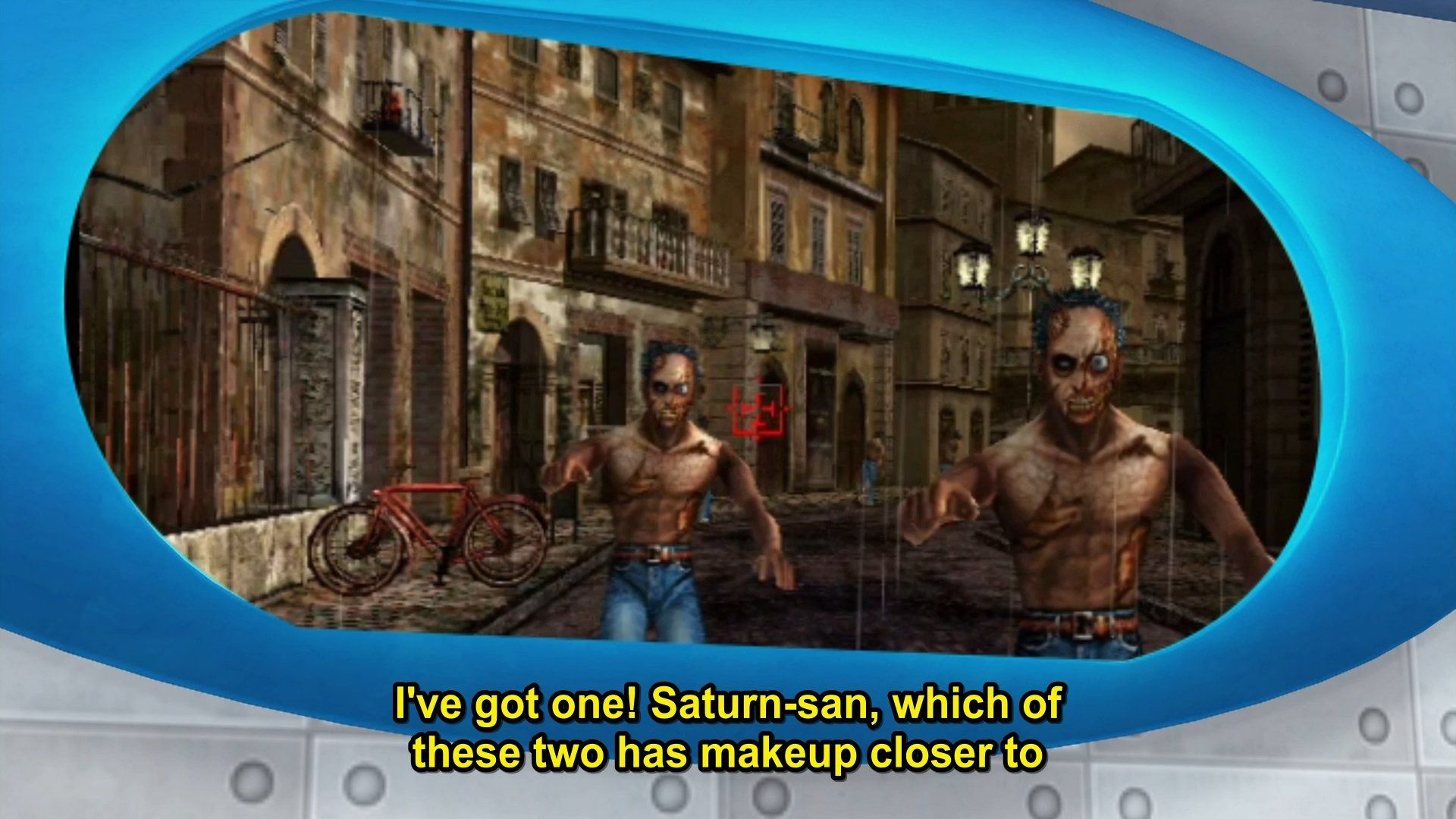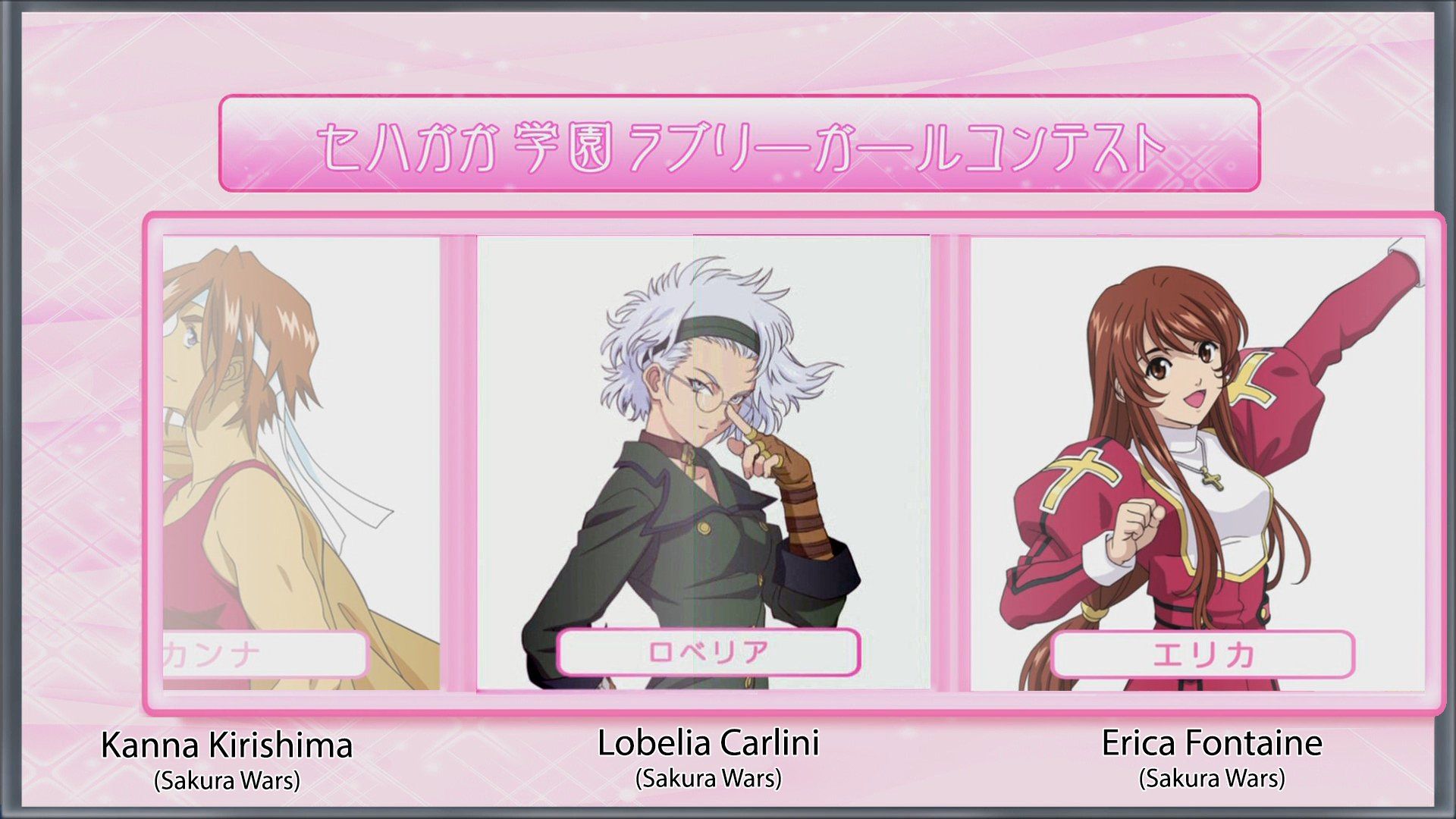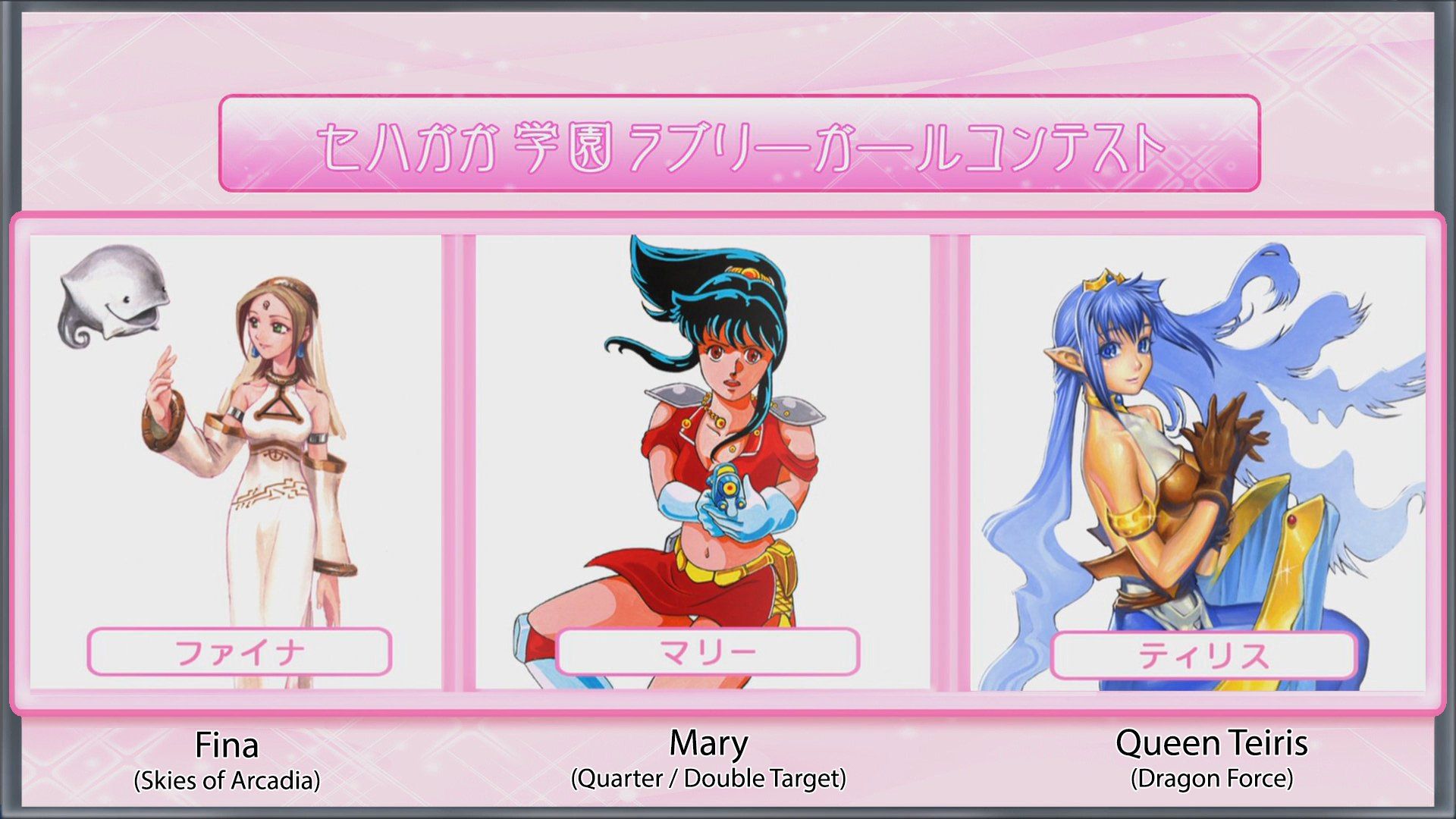[VGMP] Sega Hard Girls 5 - Episodes 5 to 8 References
Rory Joscelyne • 22 March 2022
VGMP: SEGA References from Episodes 5 to 8
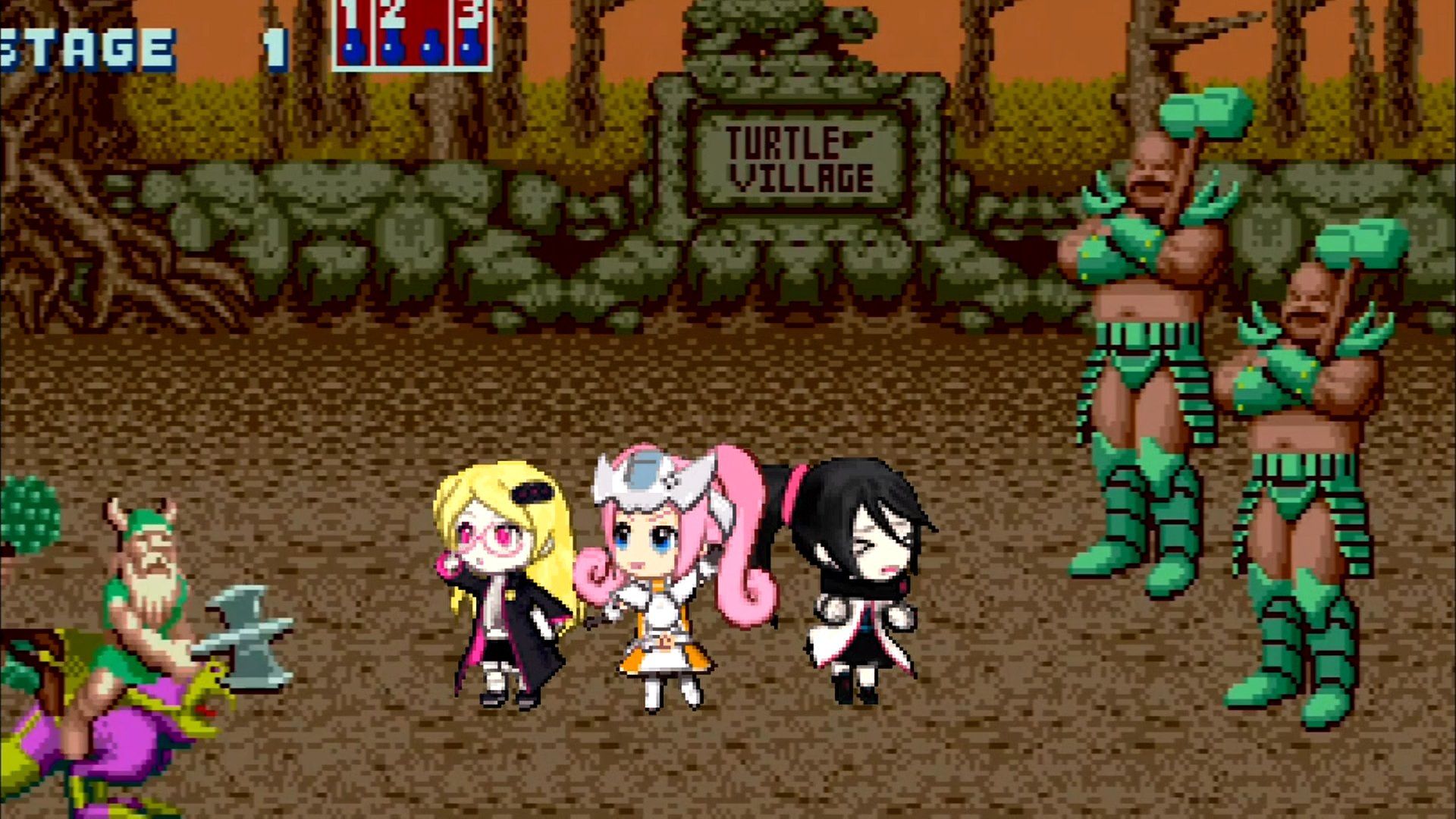
So we return to continue delving into all the references within Sega Hard Girls (2013). This will certainly be packed with a lot of references, especially Episode 8 which goes through a smorgasbord of female Sega characters from throughout their history.
PART 1
- Character References
PART 2
- Atrium References
PART 3
- Classroom References
PART 4
- Episodes 1 to 4
PART 5
- Episodes 5 to 8
PART 6
- Episodes 9 to 11
PART 7
- Episodes 12 and 13
PART 8
- Episode 14/The OVA Movie
So without further ado, put on your best Father Ted impression and get yourself prepped for episode 8 where you'll have the opportunity to say "Look at those Loverly Gals".
Episode 5 again sees Mega Drive opening her 16 BIT Encyclopaedia, and we get some in-game shots of two Sega titles.
The first shot shows the title screen for Space Harrier (1985), one of the first arcade super-scalers that gave the impression of the player flying into the screen. This is where legendary director Yu Suzuki started to build a name for himself. Despite never getting a true sequel, Space Harrier has reappeared across multiple other Sega titles and has been re-released multiple times.
The second and third shots show screens from the game Shadow Dancer: The Secret of Shinobi, which we've seen earlier in the series mentioned by Mega Drive.
City skyline
Photo By: John Doe
Button
The goal of Episode 5 is for the girls to invent a new game by putting the series "Puyo Puyo" into other existing Sega franchises.
We can see in the second shot an example with Fantasy Zone, "Fantasy Zone II: The Tears of Puyo Puyo". They do the same with the first Fantasy Zone, but essentially they just place Puyo Puyo sprites over the OpaOpa ship and several enemies.
City skyline
Photo By: John Doe
Button
Saturn suggests crossing Puyo Puyo with Virtua Fighter, and the result is simply having the Puyos blend with each other and ending the fight in a tie.
You can see in the above images that the regular puyos are rendered in the Sega Hard Girls engine, but when they are blended together they become hand drawn artwork.
The next suggestion is to blend Puyos into the world of Phantasy Star Online 2, as "Phantasy Puyo Puyo Online".
Phantasy Star is a turn-based RPG series that started on the Master System in 1987, with three sequels ending in Phantasy Star IV: The End of the Millennium" on the Mega Drive in 1993. The series lay dormant until Phantasy Star Online was released on the Dreamcast in 2000, bringing the series online and being the first online RPG on home consoles. This was followed with an additional Episode II in 2001, which released on Gamecube and ported to Xbox in 2003. A final chapter to the game was released as a Gamecube exclusive in 2003 (internationally in 2004) called "Episode III: C.A.R.D. Revolution - as the title suggests it threw away the gameplay of the previous two titles and incorporated card based game mechanics instead.
A sequel, Phantasy Star 2, was released on PC in 2012 and later on PS4 in 2016 - both Japan exclusives. Western fan outcry saw it finally
get ported to the PC and Xbox One in 2020, however the 2018 Switch port and the PS4 port both remain Japanese exclusive. Considering Sega Hard Girls was made in 2013, Phantasy Star Online 2 would have been a relatively brand new title.
It is then suggested by Dreamcast to stick Puyos into the "life simulator" title Roommania #203 (released in 2000 on the Sega Dreamcast).
This is a very weird game, and an odd choice to see several references throughout Sega Hard Girls. Essentially the man in purple is Neji Taihei, an average Japanese guy who smokes, is alone and considered a loser. You play the role of a spirit in his apartment whose job is to mess with Neji's apartment in order to force him into making positive changes in his life. Failure will see Neji remain a loser for the rest of his life. This was a Japanese exclusive title, and it's not hard to see why.
The first image is just placing Puyos in Neji's apartment. You can, again, see the resolution difference between the Dreamcast recordings and the Puyo's rendered in the Sega Hard Girls engine.
The second image is for a modification one of the girls suggests, which is Puyo Balance Ball to help Neji get in shape. However Neji simply uses the ball to relax on, with a badly photoshopped in bag of crisps and booklet (And hey, there's Professor Asobin on the cover!).
Now this might be a bit of a stretch, but the Potato Chips bag might also be a reference. I can't find any direct references to the brand "Callme" online, nor the man on the cover. However, as you can see in Image 3, the Sega Dreamcast VMU memory cards included a chip on the inside that were printed with the word "POTATO" for some odd reason. So they're either a reference to real world potato chips, or the VMU's potato chip.
City skyline
Photo By: John Doe
Button
The final suggestion is from Saturn and it's for Puyo Puyo Waterslide. While there's not much here but more Puyos, this area comes back later in the series and in the Episode 14 "Hang On" special but this is likely the only place I can really reference it.
On to episode 6.
Episode 6 sees the Sega Hard Girls transported into the world of Border Break: Sega Network Robot Wars (2010) - an online mech shooter only in Arcades and on the Playstation 4. The game never made it to the West, only appearing in Japan, Hong Kong and Taiwan.
The first two images show clips explaining the gameplay of Border Break, the first of which I assume is from the in-game art style as the cow-man is not animated and doesn't match anything else in the episode.
The final image is a character select screen for one of the characters of Border Break, Fiona. Because we never see any pure gameplay, I am unsure as to whether or not this character would appear on screen in-game at any point.
City skyline
Photo By: John Doe
Button
Here we see the in-game graphics up close, note the Mega Drive avatar on the mech's shoulder. It's possible custom patches could be done in the original game, as these render in the game footage just fine. Because of the low budget nature of the series, super-imposing it across multiple shots would likely have been too expensive or time-consuming.
The second image shows the cockpit artwork that Mega Drive and Dreamcast both occupy throughout their time in the mechs. Saturn doesn't get a mech, which is part of the story. I'm pretty sure this background is part of the show and not from the game, however I don't know that as a fact.

To throw a spanner into the works, Eggman appears and zaps the girls so that they lose their mechs and shrink back down to their chibi forms.
His appearance includes one of the girls shouting "That bald bastard...", which would normally seem too severe for a seemingly child-friendly cartoon. However we have to remember that Japan didn't materialise from Latin, and that certain swear words don't really apply as curses in the Japanese language. Another example of this I've seen is in the Japanese version of Sonic X when someone calls Rouge the Bat a "Bitch".
Things like this are the reason we have localisation in media, and not just straight translations.
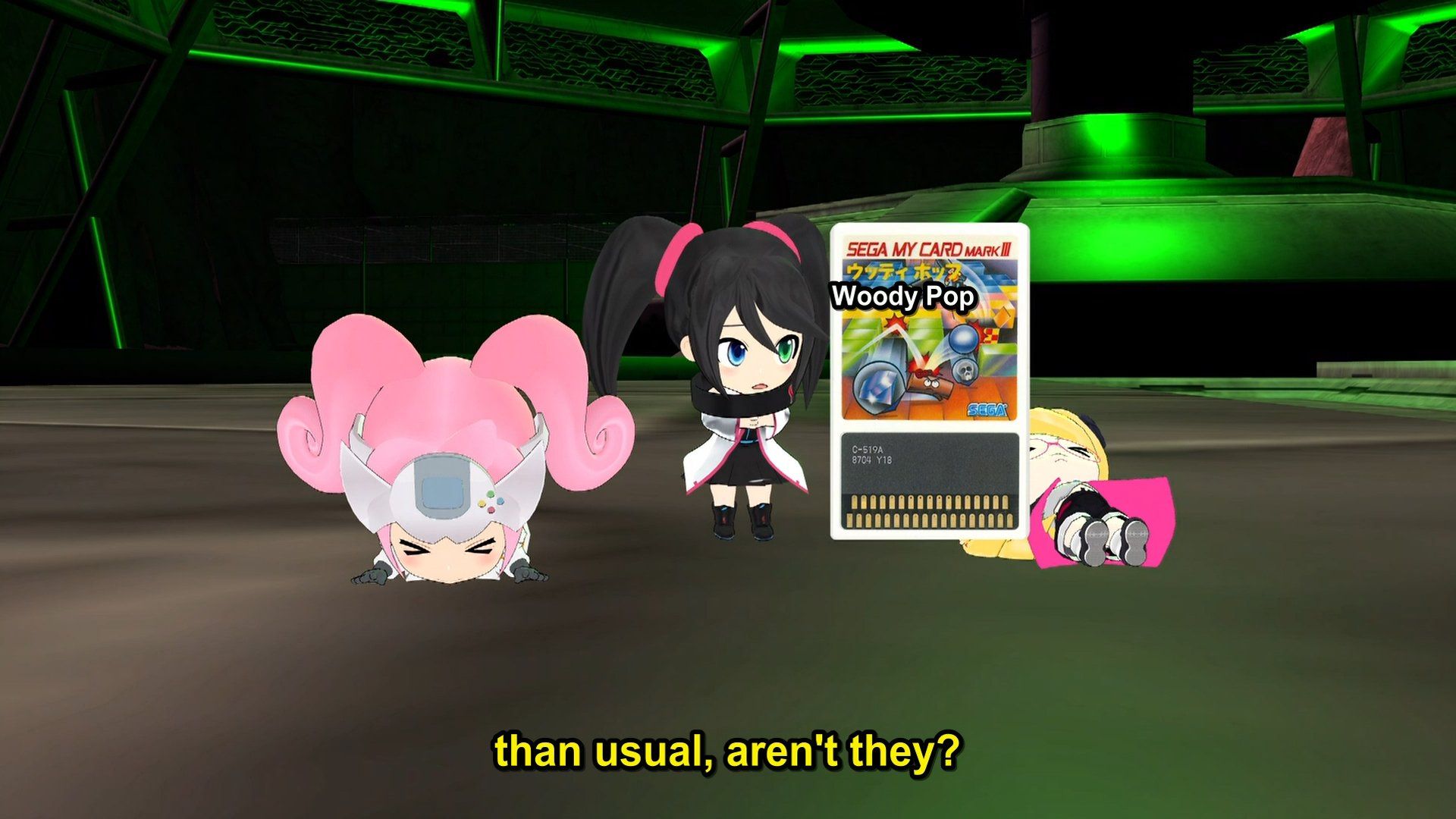
An odd frame of reference is brought up by Saturn when she realises they've all been chibified again (and as such are physically helpless). To get across just how big they are, she mentions that they are the size of a Sega My Card - the SG-1000 Mark III credit-card sized games mentioned in a previous article.
The game itself (despite not being important in the reference itsef) is Woody Pop (1987), a ball-and-paddle title similar to Breakout or Arkanoid. It was the last game released in Japan under the Mark III branding (everything following would be under the Master System brand) and was designed to work exclusively with the Paddle Controller. It saw an international release on the Game Gear, no longer requiring a unique controller.
While this makes for an excellent reference, it's a strange one because you would have to know
the size of a Sega My Card in order to understand what she means. For anyone not aware, they are literally the size of a credit or debit card, which means the girls aren't very tall in this form at all.

The very last thing to happen in Episode 6 is the arrival of Sonic the Hedgehog. It has to be said that the appearances of Sonic and Robotnik, while they should have been the standout cameos of the show, were thoroughly ruined by the fact both were completely mute. And while I thoroughly enjoyed the mute characterisations of Sonic's characters in Sonic Mania Adventures (2018), those animations were purposely designed to express thought and emotion through facial expression and strong animation. Sega Hard Girls doesn't have this going for it, instead having the main three girls narrating every single thing we're seeing on screen. Episodes 6 and 7 are definitely where the show takes a dip, but it does manage to rebuild it's absurd and intriguing quality from Episode 8 onwards.
Episode 7 is largely the battle between Sonic and Robotnik, with very little else going on and few references. That being said, there's still several worthy of mention. The chibified girls all hang on to Sonic as he chases Robotnik through some kind of warp zone, and we get some brief shots of Sonic in Sonic the Hedgehog (1991) and the heads of the girls spinning whenever he hits loops or spins around.
The first image is the SEGA logo first seen in Sonic the Hedgehog, and also includes the first in-game use of the now famous Sega Choir (singing "SEGA!").
The second shows the girls struggling as Sonic hits a loop in Green Hill Zone. the third shows Mega Drive's happy reaction to realising where they are. The fourth shows the girls as they're bewildered by the trippy appearance of the Special Stages in the game.
The final image shows Sonic in the world of Sonic Adventure (1999), with Eggman in the distance. Compared to Eggman's earlier appearance in Border Break, this is far better made. He's been slapped on in Photoshop on both occassions, but in this image there's no massive black border and he just blends into the environment a little better.
City skyline
Photo By: John Doe
Button
As the fight between Sonic and Eggman continues, Eggman brings out a Wrecking Ball on a chain. This is the same weapon he used in the Green Hill Zone boss of Sonic the Hedgehog (1991). This is a great reference and fits the scene as well.
After the characters are knocked back into Border Break, Mega Drive uses her 16 BIT Encyclopaedia to conjure up an invincibility item box to help Sonic defeat Eggman.

As the episode closes, we see a mysterious figure appear on the screen, which is supposedly a sneak peak at the real identity of Center-Sensei. The design is quite clearly meant to hint at Yuji Naka, the former head of Sonic Team and programmer for the original Sonic the Hedgehog.
The art style isn't just random either. It's a very clear reference to another Sonic Team game - this time for the Nintendo DS and released in 2004. The game has three different titles, depending on region;
I Would Die For You - Japan
Feel The Magic: XY/XX - America
Project Rub - Europe
This was a hugely stylised dating simulation game where the characters were almost pure silhouettes, with clothing portrayed by a different coloured silhouette. The concept of the game was to use the Nintendo DS touch screen to complete minigames and then use your skills to impress a young woman... by rubbing her. It's not quite
as pervy as it sounds but... yeah. It also spawned a sequel called The Rub Rabbits in 2005/2006, and it also inspired the 2020 Nintendo 3DS title The Queen TV-Game 2 with it's visual design.
City skyline
Photo By: John Doe
Button
Finally, the episode ends with a preview for Episode 8 (though it's a bit of a false preview) by showing the title screen for House of the Dead 2, an arcade and Dreamcast light gun game. The second image is from Episode 8 itself, but essentially all that happens is they throw a costume party (which goes nowhere) and then they have a Lovely Girls competition.
In America, due to the Columbine Shootings, Sega decided not to release the light guns in that region - but they also coded the US releases specifically to not recognise
any
official light gun, meaning that they wouldn't work even if you imported the guns from Japan or Europe. Fans have since modded the game code to remove this lockout, however as Dreamcasts are easy to break region lockouts on Americans can just play the Japanese or European versions instead.

I'm going to jump to the final reference of the episode, which is the reveal of Bongo the Ape from Congo Bongo, apparently female according to the Sega Hard Girls show (though this isn't explicitly stated in the game). Congo Bongo (also known as Tip Top) was released in Arcades in 1983, and soon saw a Sega SG-1000 port that same year.
The arcade version is an isometric game, in an attempt to improve visually on the popular Donkey Kong franchise, whereas the SG-1000 is a flat 2D platformer. It also saw home releases on the Apple II, MSX, Intellivision, ColecoVision, Commodore 64, VIC-20, IBM PC, Atari 2600, Atari 5200, Atari 8-bit and the Texas Instruments TI-99/4A.
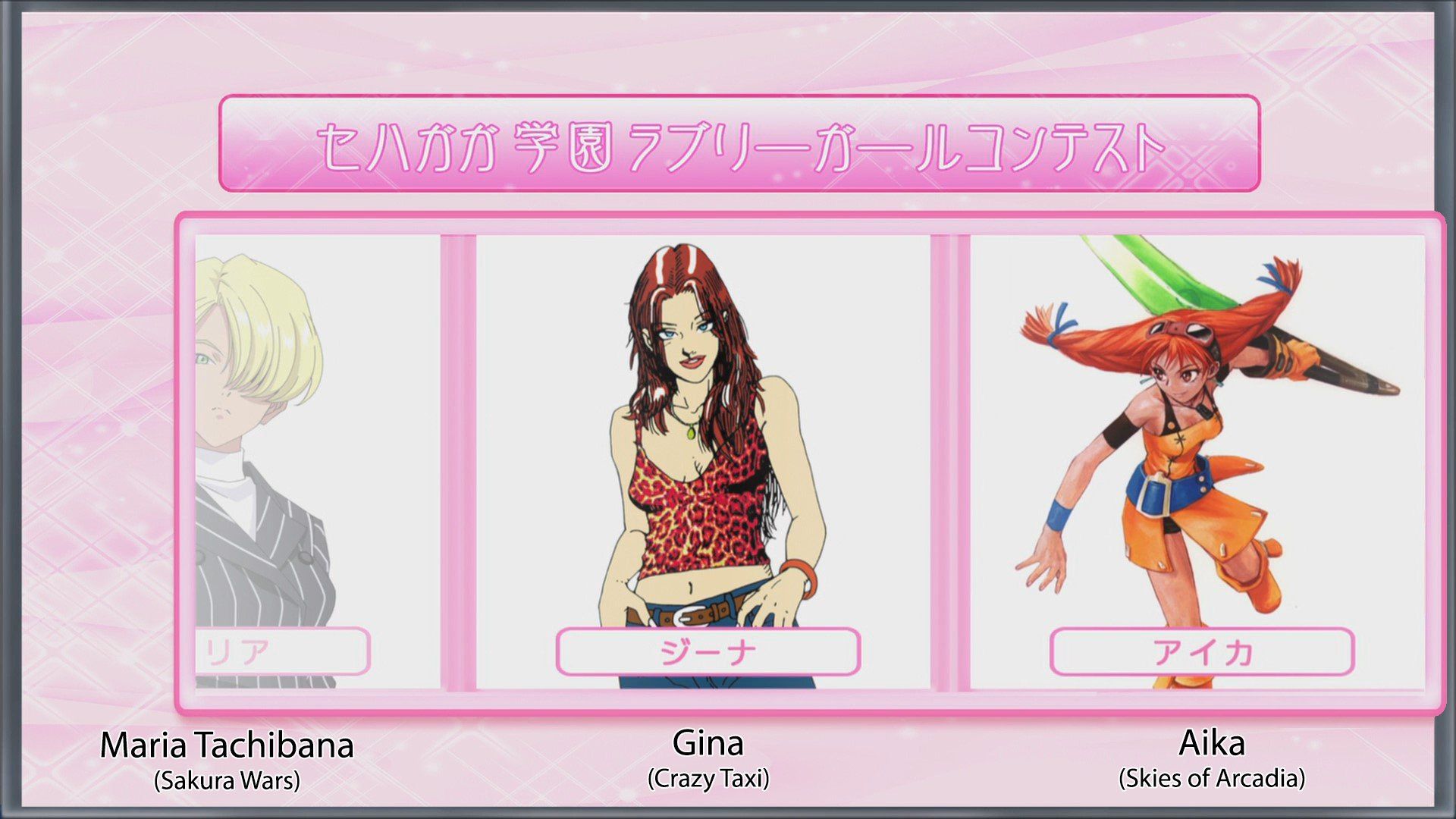
So we now start the long list of women mentioned in the Lovely Girls competition. If you were ever curious as to how many female characters Sega had, then buckle in - and this isn't even every female character they have! Bear in mind the series as a whole focusses strongly on franchises popular in Japan, so there's going to be a large chunk of popular characters missing.
So we open with Maria Tachibana, a pin-stipe suited woman with a blonde bob hairstyle. She's from Sakura Wars and appeared all the way up to the fourth entry in the series. She's supposedly from the Ukraine (mixed Japanese-Ukranian parentage), and is stated by Ogami to be a rather strict person, but also added "I finally feel as though I've met someone who actually seems like military personnel."
In the middle we have a woman who couldn't be more opposite. Gina is one of the four taxi drivers in the original Crazy Taxi, and while she sounds like a mixture of relaxed and baked, the aim of her game is drive as crazily through the streets to reach her destination is as little time as possible. The last complete release of Crazy Taxi was on the Sega Dreamcast, as it still included references to Pizza Hut, KFC, FILA and Tower Records - as well as including a banging soundtrack from The Offspring and Bad Religion. While the game has been re-released on Gamecube, Playstation 2, PC and Xbox 360, these versions lack the brand references and include a generic rock soundtrack that in no way measures up to the MTV vibe of the original.
On the right we have Aika from the game Skies of Arcadia (known as Eternal Arcadia in Japan) which came out on the Dreamcast as a turn-based RPG with a heavy focus on exploration. The game was released to critical acclaim but sadly suffered poor sales. It was re-released on the Gamecube as Skies of Arcadia Legends but sadly that didn't sell well either. Despite this the game has a strong fanbase and holds as one of the best RPGs of its era.
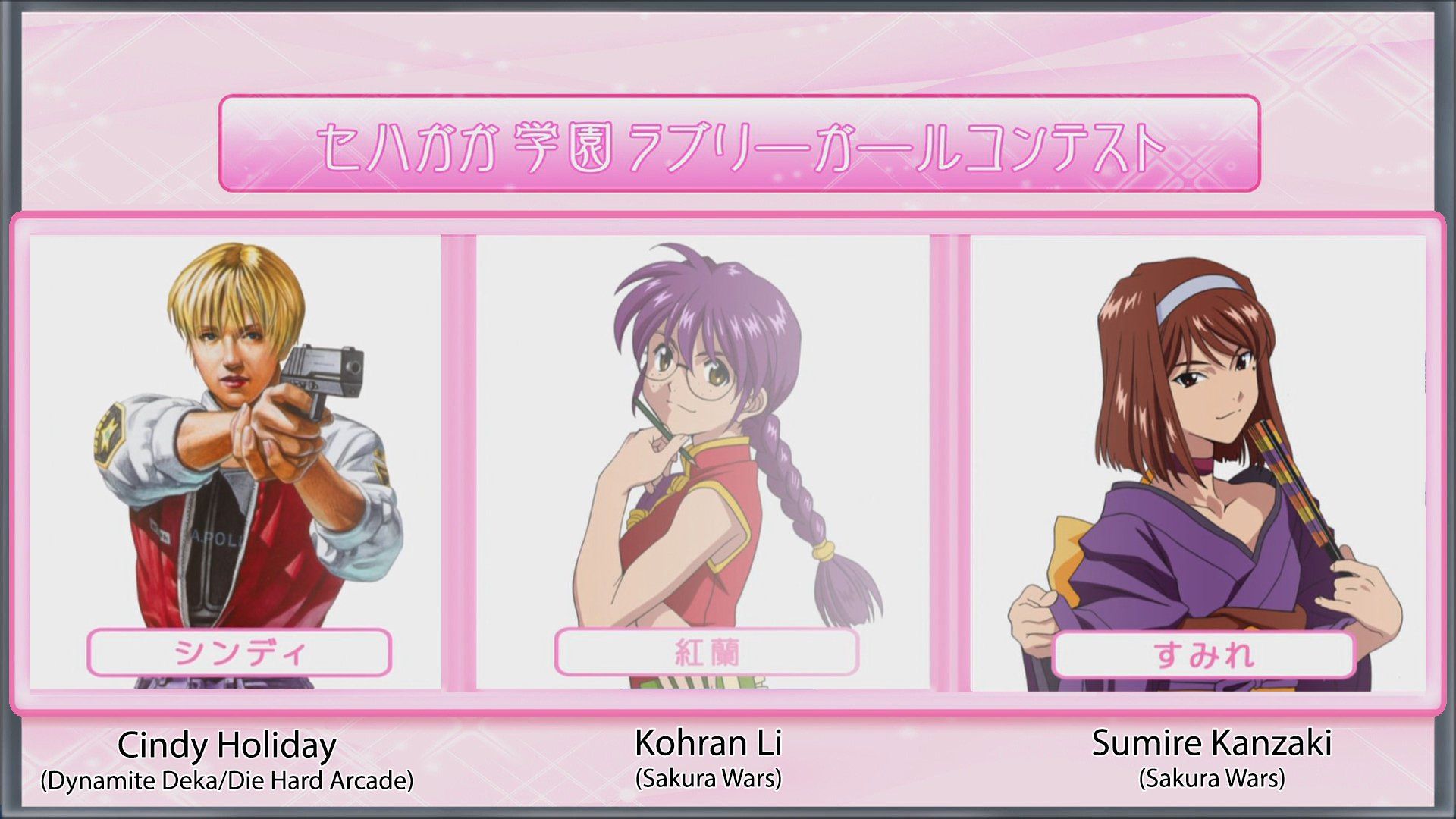
Cindy Holiday is the Player 2 character in Dynamite Deka/Die Hard Arcade. While she isn't initially available in the sequel on Dreamcast (Dynamite Deka 2/Dynamite Cop), she can be accessed by downloading the Detonator Pack DLC. This was available in Europe via the DreamOn official demo discs that came with the official magazine, however it can easily be found online and downloaded. Just press Start when hovering over Jean Ivy on the character selection screen.
Kohran Li and Sumire Kanzaki are two additional characters in the Sakura Wars series.
Because there are a total of 11 Sakura Wars characters in this lineup, I decided to put them all in one gallery above.
Image 1: Reni Milchstrasse, Glycine Bleumer, Orihime Soletta
Image 2: Kanna Kirishima, Lobelia Carlini, Erica Fontaine
Image 3: Coquelicot, Hanabi Kitaoji
You can find a great resource for more information on these characters at
www.sakurawars.fandom.com
The rest of the girls (that aren't from Sakura Wars) are in this gallery. I won't delve too deep into each title, as you can look that up if you are unaware of a title, however the following characters are shown;
IMAGE 1: Fina -
Skies of Arcadia (2000), Mary -
Quartet (1986), Queen Teiris -
Dragon Force (1996)
IMAGE 2: Pudding
-
Space Channel 5 (2000), Honey -
Fighting Vipers (1995), Rika -
Phantasy Star IV: The End of the Millennium (1993)
IMAGE 3: Tyris Flare
-
Golden Axe (1989), Sarah Bryant and
Pai Chan -
Virtua Fighter (1993)
IMAGE 4:
Ulala -
Space Channel 5 (2000), Amy Rose -
Sonic the Hedgehog series (1993),
Gilius Thunderhead - Golden Axe (1989)
IMAGE 5: Lisa Rogan -
House of the Dead III (2002), Powell -
Dynamite Deka/Die Hard Arcade (1996) , Gum -
Jet Set Radio (2000)
That sums up the references in episodes 5 to 8. We've come a long way, but there's still more to come. The next article will be Episodes 9 to 11. The reason I'll be doing 3 instead of 4 that article is because 12 and 13 are the series finale, and the references work better as one article (and there is a LOT to cover). However Episodes 9 to 11 are no slouches - with the Girls not only having to play the latest Sega games, but simultaneously run into Sega characters from as far back as the early 80s.
Please check back regularly for updates, and do follow our podcast including our episode on Sega Hard Girls at
www.vgmovie.co.uk.
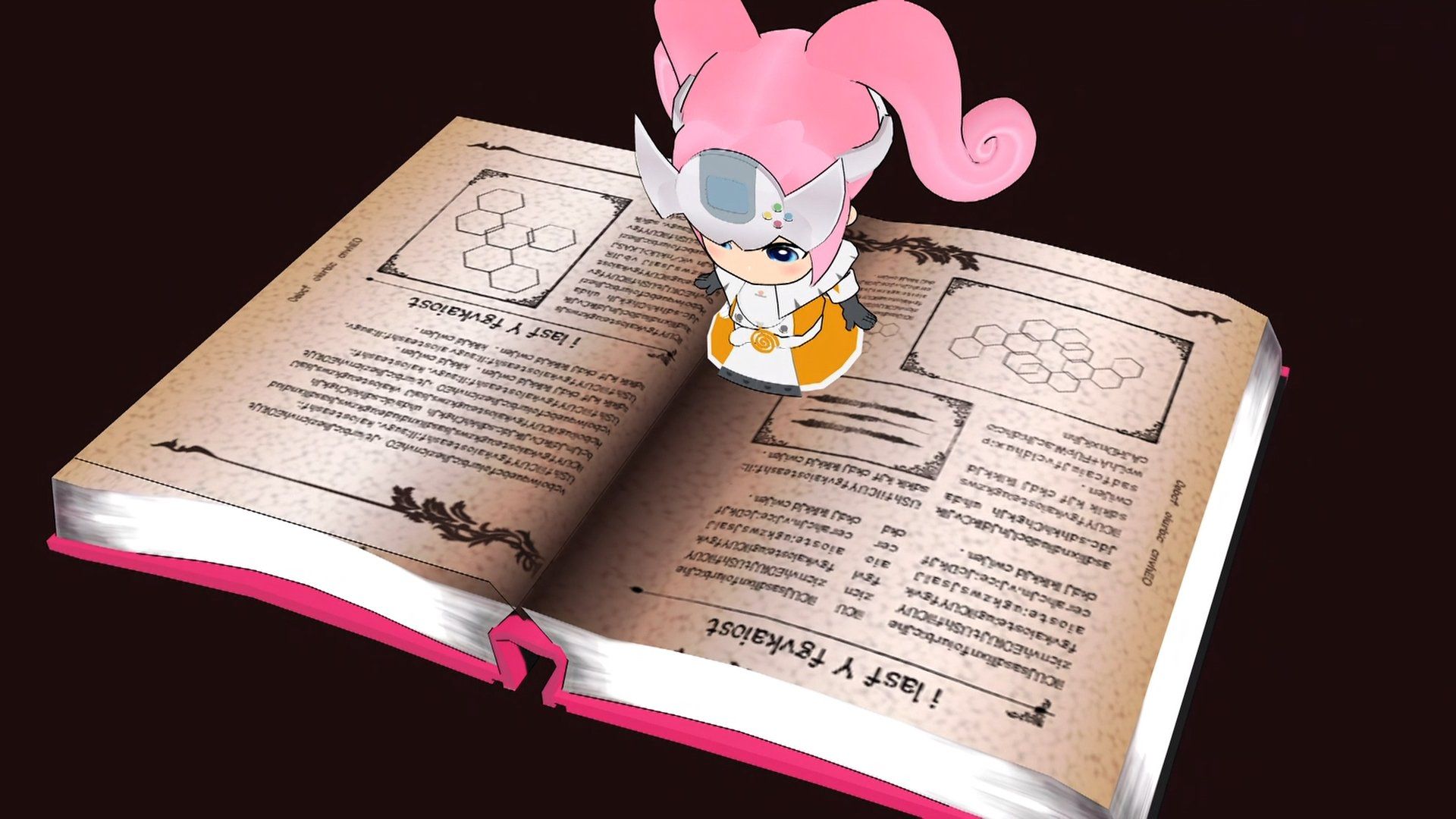

Blue Streak, speeds by... Sonic the Hedgehog (2020) is Hollywood's first big blockbuster attempt to bring Sonic to the big screen. A much more popular effort than the 1996 anime movie, this one sees Sonic come into the "real world", but that doesn't mean that it isn't jam-packed full of Easter Eggs. And some of them are references to other Sega franchises.

First things first - DO NOT WATCH THIS MOVIE. Kung-Fu Master may have the licence for the game, and it may include a few scenes at Arcades, but the story is nothing to do with gaming - and the story it represents is a literal crime. A vile, vile crime. With that out of the way, there are some interesting arcade machines visible throughout this film - all of which are here. So you have been saved from having to watch this vile garbage - and saving you the criminal act of watching it.
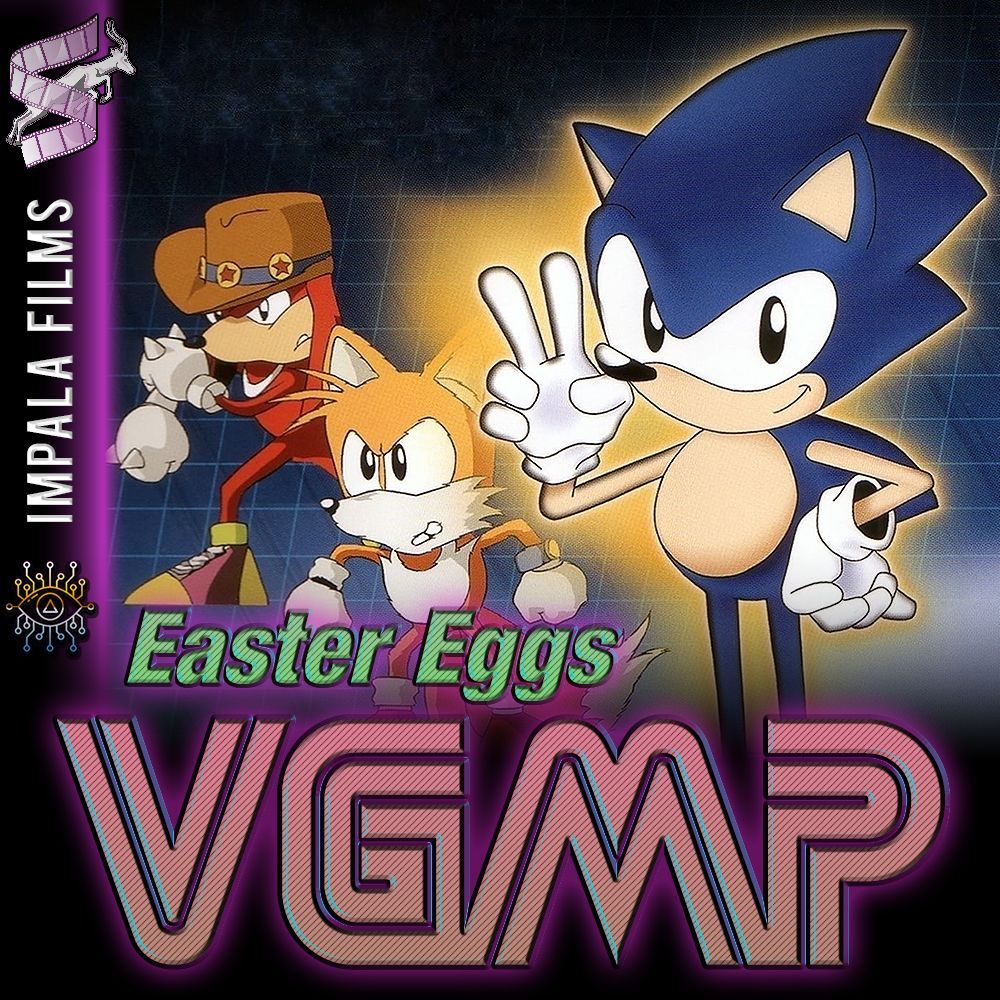
Also known as Sonic the Movie, the Japanese OVA was actually a run at a possible series that never materialised, instead leaving us with two episodes hastily stitched into a "feature". And boy, did they push taste and decency for some of this. Other than Robotnik chasing underage skirt, it's largely inoffensive. But unfortunately that story angle wound up kick-starting a long running VGMP joke of Sonic adaptations having to reference breast milk (which the 2020 Sonic movie also references).
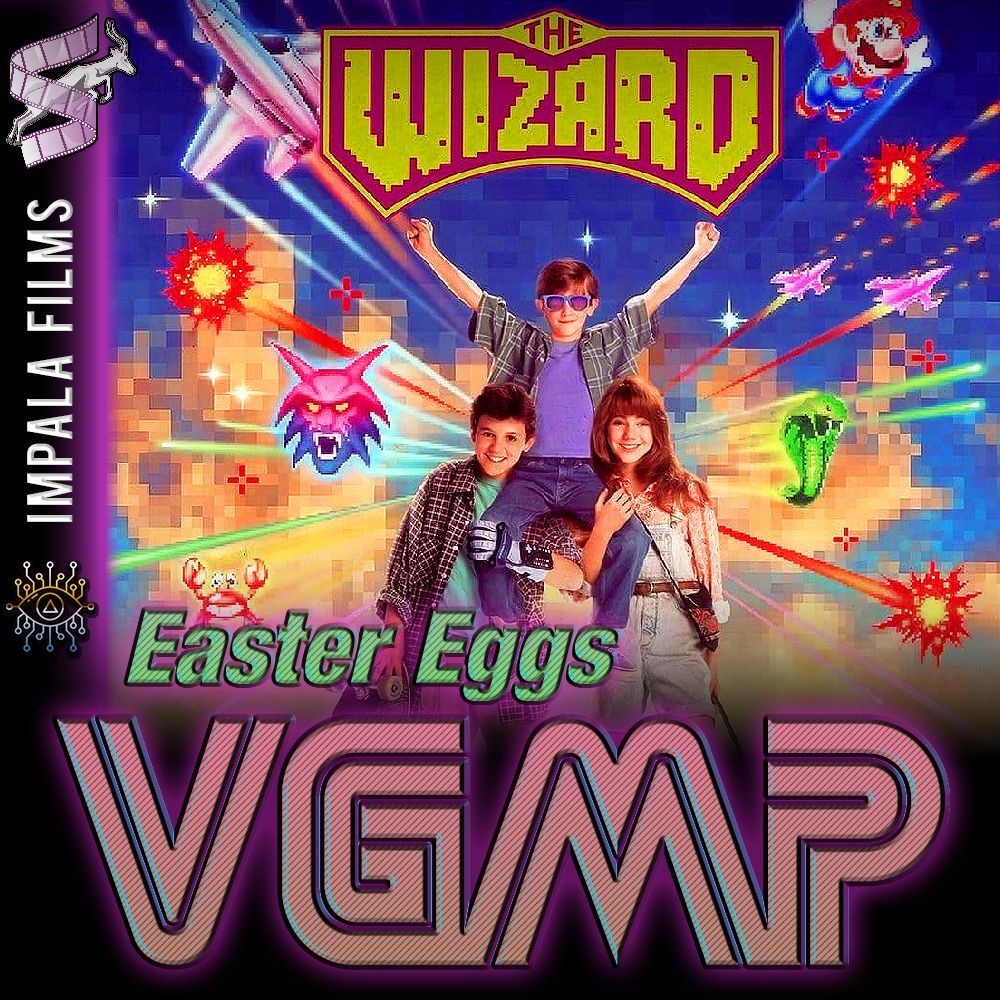
I love The Wizard. It's so bad. The first major disagreement between Rory and Jamie in VGMP, Rory fully recommended The Wizard as a movie, whereas Jamie fully rejected it. It's not hard to see why this movie caused such a rift of opinion - it genuinely tries to be a deeper and emotional story, but it's still a Nintendo marketing product (and an out of date one, at that). One thing The Wizard does have, is a lot of videogame references.

The House of the Dead movie brings together two major events in film. It's the first foray by Uwe Boll into video game adaptations - the start of a terrible career. And it was the last ever movie to use the turn-table technique for 360 degree shots, as it was too dangerous to keep using - much like allowing Uwe Boll to have a film career. This film doesn't have many proper references, instead lazily throwing in random micro-shorts from the first three House of the Dead games (in no particular order, for some reason).
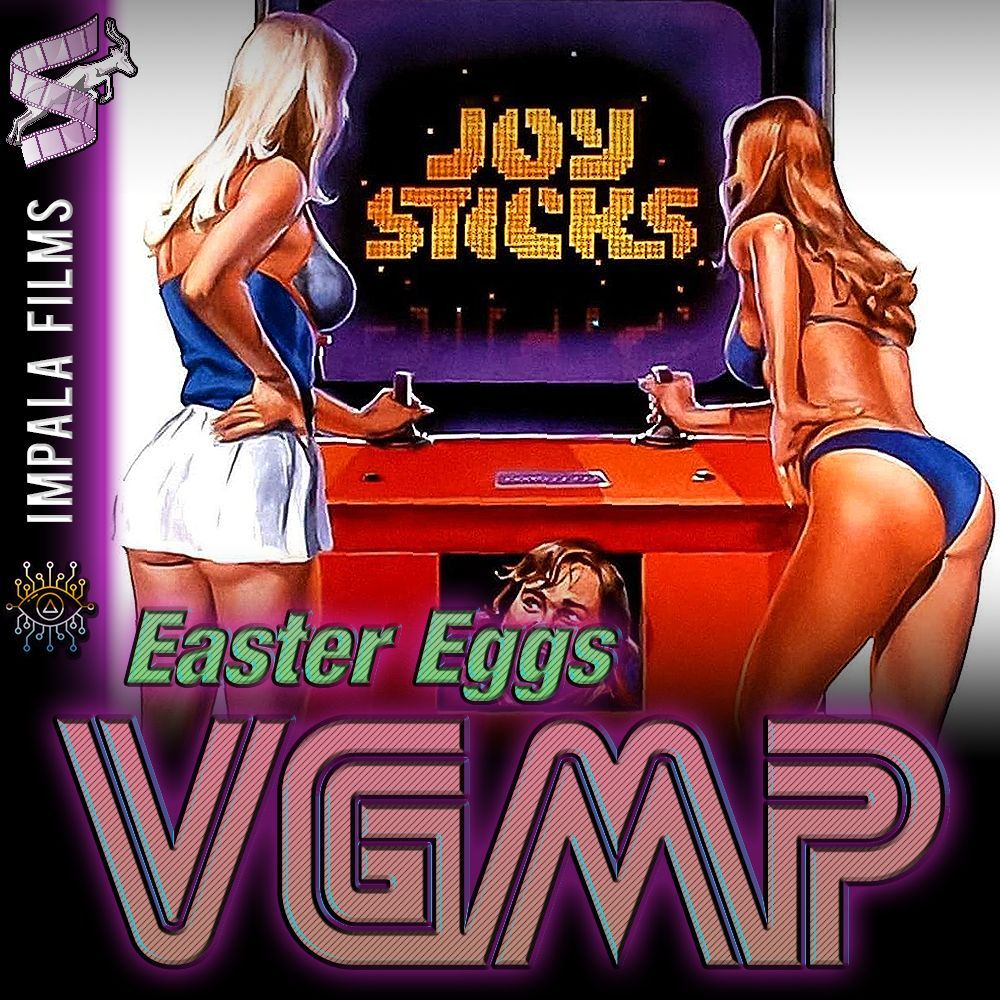
The first appearance of Jon Gries in a video game culture movie, and he would return in Noobz (2012) to steal yet another movie. Joysticks is an awful comedy movie, attempting to cash in on cheap teen humour of the time with a big dose of objectifying women. But to it's credit, it does showcase a lot of great arcade cabinets from 1983, and all in fantastic condition too! These screengrabs are ripped from the limited-run Blu-Ray release of the movie, which represents the best this film has ever looked. However this was a relatively low budget feature of it's time, so don't expect prestine visuals.

Tron is an undisputed 1982 classic that had a major impact on 80's culture and gaming aesthetics as a whole. And yet, when we reviewed it, it turns out the movie itself is a big bag of style over substance. The main videogame the movie revolves around is Space Paranoids, and it is not a real game. Several videogames were later made of Tron, but none of those appear in this movie.

Gamebox 1.0 is an odd 2004 movie starring the guy who played Harvey in Sabrina the Teenage Witch. You could technically call it a dramatic horror, if any of it was dramatic or a horror. As you can see from the shot above, the details were so vital to this film that there's a guy at "work" just staring at a blank screen. Regardless of the low budget nature of the film, there are still a surprising number of references hidden in this movie.



